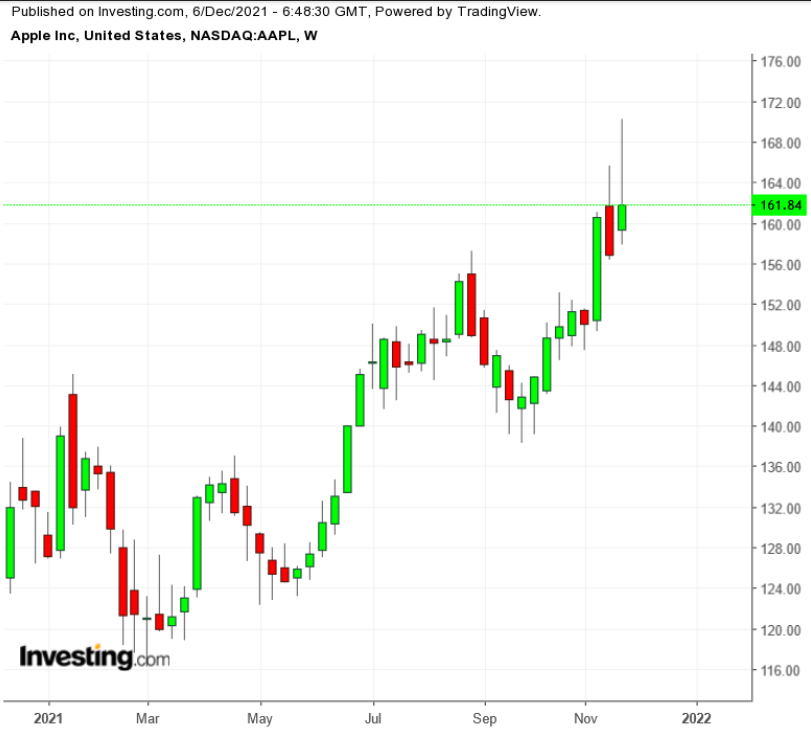Unlike many other stocks, shares of iPhone-maker, Apple (NASDAQ:AAPL) are holding up quite well during the current bout of market volatility, triggered by the emergence of a new COVID-19 variant, Omicron.

While other technology stocks took a big hit as investors exited risky growth-oriented assets, the world’s largest company by market cap showed resilience. Its stock has hardly budged during the past two weeks, even when the tech-heavy NASDAQ 100 Index plunged more than 6%.
This outperformance is also surprising given some evidence that the Cupertino, California-based company is struggling to meet demand as the global supply-chain bottlenecks hinder its ability to produce more hardware during the crucial holiday season.
While that issue lingers globally, Apple also warned its suppliers last week that demand for its flagship iPhones is slowing. Apple, which had already cut its iPhone 13 production goal for this year by as many as 10 million units from a target of 90 million, is now informing vendors that some of its orders may not materialize, according to a report first published by Bloomberg. Apple CEO Tim Cook expects revenue growth for the current quarter, but supply constraints will cost the company at least $6 billion in missed revenue.
This weakening demand environment coupled with the Omicron-related uncertainty has so far failed to bring the kind of correction for the stock for which many investors on the sidelines are waiting. One explanation for this unusual strength is that investors now see Apple as a safe haven asset with the ability to endure the economic shocks much better than some peer equities. The company has a rock-solid balance sheet and more than $200 billion in cash in banks.
Amid speculation about its future growth, the company continues to produce very powerful revenue gains across its many businesses. In the previous earnings season, Apple reported a whopping 36% surge in sales which crossed $81 billion for the three-month period.
Apple's core product, the iPhone, grew about 50%, confirming that this business segment is entering another super-growth cycle despite supply chain issues—fueled by the 5G-enabled iPhone models. AAPL's wearables, home and accessories segment also grew 36%. That category includes the Apple Watch, AirPods, Apple TV, the HomePod and various other accessories.
Apple Cars, Glasses And Headsets
Needham analyst Laura Martin told CNBC in a recent interview that investors are turning to Apple because it can endure any slowdown in the economy and take advantage of falling prices.
Apple, noted Martin, is positioned to introduce new products to power more growth. She added:
“The biggest criticism of Apple for the last five years is no new products. When you look at the product pipeline, lots of excitement there, especially in the press today about how they’re going to introduce augmented reality glasses at the next WWDC in June.”
Apple’s potential entry into the autonomous vehicle space is another upside potential that investors are keeping an eye on. The company is pushing to accelerate development of its electric car, refocusing the project around full self-driving capabilities, according to a report from Bloomberg.
Morgan Stanley analyst Katy Huberty wrote in a recent note that this report lends credibility to the idea that Apple’s car launch could both accelerate adoption of new technology and expand the addressable market similar to past Apple product launches. She said:
“We can provide a number of examples from the last 20 years that show while Apple may not always be first to market, its innovation engine, differentiation via vertical integration, and manufacturing/operational excellence have allowed it to leapfrog first movers.”
Bottom Line
There may not be a chance for investors to buy shares of Apple more cheaply in the current market volatility as the stock continues to show resilience. But when and if a dip occurs, investors shouldn’t miss out on that buying opportunity.
